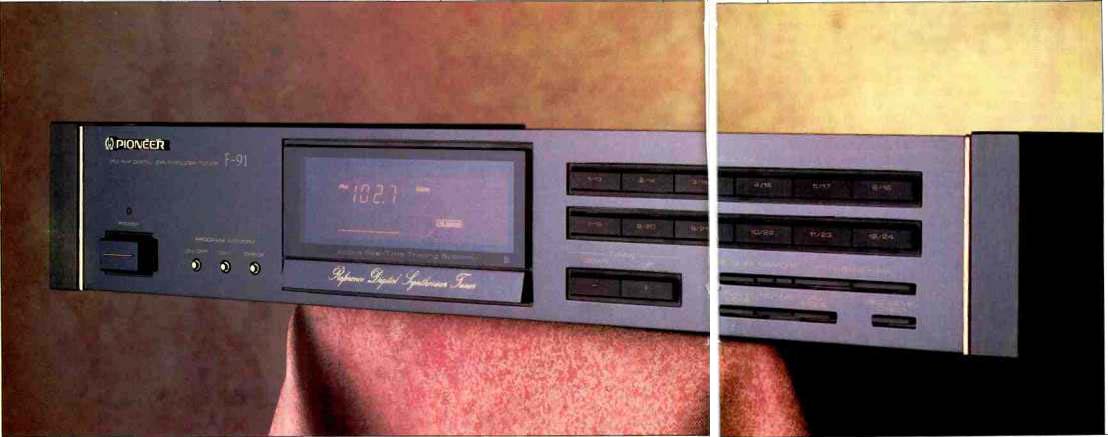
Manufacturer's Specifications:
FM Section:
Usable Sensitivity: Mono, 9.8 dBf.
50-dB Quieting Sensitivity: Mono, 12.8 dBf; stereo, 34.8 dBf.
S/N Ratio (at 80 dBf): Mono, 95 dB; stereo, 87 dB. THD (at 80 dBf): Mono, 0.015% at 100 Hz, 0.009% at 1 kHz, 0.02% at 6 kHz; stereo, 0.02% at 100 Hz, 0.02% at 1 kHz, 0.07% at 6 kHz.
Capture Ratio: 0.8 dB.
Alternate-Channel Selectivity: 85 dB.
Frequency Response: 20 Hz to 15 kHz, +0.2,-0.8 dB.
Image Rejection: 70 dB. I.f. Rejection: 100 dB.
AM Suppression: 70 dB. Spurious-Response Rejection: 80 dB.
Subcarrier Rejection: 60 dB.
Muting Threshold: 25.2 dBf.
Stereo Separation: 65 dB at 1 kHz; 55 dB, 20 Hz to 10 kHz.
FM Output Level: 650 mV at 100% modulation.
AM Section:
Sensitivity (Loop Antenna): 150 µV/m.
Selectivity: 40 dB. S/N Ratio: 50 dB.
Image Rejection: 40 dB.
I.f. Rejection: 60 dB.
AM Output Level: 150 mV at 30% modulation.
General Specifications:
Output Impedance: 900 ohms.
Power Requirements: 120 V a.c., 60 Hz, 25 watts.
Dimensions: 18 in. W x 3 5/16 in. H x 12 7/16 in. D (45.7 cm x 8.4 cm x 31.6 cm).
Weight: 11 lbs., 7 oz. (5.2 kg).
Price: $600.
Company Address: P.O. Box 1720, Long Beach, Cal. 90801, USA.
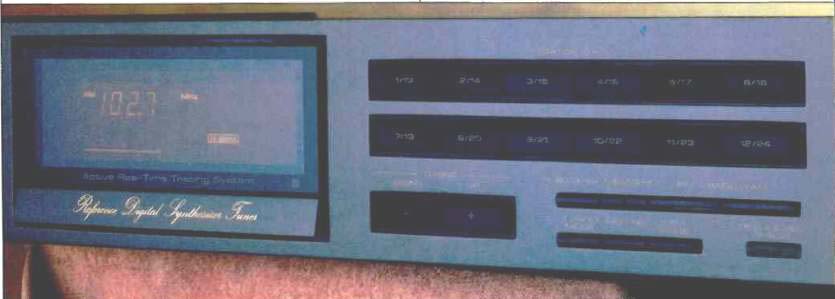
Rather than design a "me too" tuner, Pioneer's engineers have come up with some innovative circuits in the Elite F-91 that result in measurably better and audibly better FM performance. The first of these is an FM i.f. circuit that has been given the acronym ARTS (for Active Real-time Tracing System). This system eliminates the need for choosing between narrow and wide i.f. bandwidths. Pioneer states that it actively follows the selected signal to provide both the lower distortion normally resulting from wide bandpass and the high selectivity of narrow bandpass. From my station logging and listening tests, I gathered that the system dynamically tailors bandwidth to the instantaneous modulation of the incoming signal. I also saw evidence that the r.f. section has some capability of tracking the signal; even when my FM signal generator was deliberately detuned from the frequency indicated on the F-91's display, minimum distortion and perfect center tuning were maintained.
The second circuit innovation in the F-91 is described as a Digital Direct Decoder, Type Ill. This stereo demodulation system takes the output of the ARTS i.f. circuitry and converts it into digital form before converting the signals into stereo analog outputs. Pioneer maintains that this digital operation reduces noise, distortion, and signal degradation.
Improvements also have been made in other circuits, such as the r.f. front-end, to provide sensitivity and selectivity that are equivalent to those of a tuner with a four-gang tuning capacitor.
Among the F-91's many convenience features, its 24 station presets memorize not only station frequency, but also such characteristics as the preferred mono/stereo and high-blend settings for each station. The automatic tuning circuit gives you a choice of three signal strengths below which it will ignore incoming signals. For unattended recording in conjunction with an external timer, the F-91 can be set to tune in three different preselected stations as the timer turns it on and off. The F-91 also has a built-in audio signal generator, tuned to around 330 Hz. When switched on, output from the tuner is equivalent to 50% modulation level.
This signal can therefore be used to set up recording levels on a tape recorder prior to the beginning of the program you want to record.
Structurally, the F-91 makes extensive use of anti-vibration materials. A "honeycomb" chassis and large insulators are used to achieve high rigidity. Local circuit blocks are built into modules and filled with epoxy resin to damp any resonances.
Control Layout
A power switch and the pushbuttons needed for programming unattended recording are located to the left of the major display area. This fluorescent display indicates AM or FM frequencies, station preset number, program memory mode, auto-tuning threshold level, signal strength, muting, and stereo/mono status. When the high-blend mode has been selected, that fact is also displayed, as is the activation of the record-level check function.
Twelve numbered pushbuttons to the right of the display are used to program and select presets. Presets 13 through 24 are selected by pressing another pushbutton that acts as a shift key. Fairly large "Up" and "Down" tuning buttons are located below the station presets, as are eight smaller buttons. The upper row of these includes the shift key and buttons for memory sexing and FM and AM band selection.
Below them are buttons for "Tuning Mode," "Muting" on/off, multiplex mode, and, a bit to the right, the record-level generator switch. The tuning and multiplex mode buttons operate sequentially: Pressing "Tuning Mode" cycles the Elite F-91 through manual and three levels of automatic tuning, each requiring a higher minimum signal strength before it will lock in on a station. Pressing the "MPX Mode" button selects stereo, mono, or high-blend operation.
The rear panel is equipped with a 75-ohm coaxial connector for hooking up the FM antenna transmission line. An accessory transformer is supplied for those who use 300 -ohm, twin-lead cable. Spring-loaded terminals are provided for the supplied AM loop antenna, which does not mount on the tuner's rear panel, as is usually the case, but is designed to stand or be mounted wherever it will pick up AM signals best. Two control input terminals are also provided, for interconnection with other Pioneer components bearing the "SR" symbol. (This symbol denotes that these components can be operated via a remote-control module supplied with Pioneer amplifiers bearing that same mark.) The usual left- and right-channel output terminals complete the layout of the rear panel.
Measurements
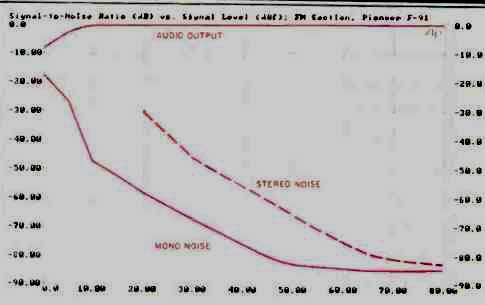
Fig. 1--Mono and stereo quieting characteristics, FM section.
Figure 1 is a plot of mono and stereo residual noise as a function of signal strength for the F-91's FM section. In mono, 50-dB quieting was attained with a signal strength of only 12.5 dBf, a bit lower than the 12.8 dBf claimed by Pioneer. In stereo, 50-dB quieting was reached with an input signal level of only 34 dBf, again slightly below the 34.8 dBf claimed by the manufacturer. While I was unable to confirm Pioneer's specs for ultimate signal-to-noise ratio of 95 dB in mono and 87 dB in stereo (my signal generator's residual noise was a limiting factor here), I did register readings of 85.5 dB in mono and 83 dB in stereo for an input signal level of 80 dBf. The EIA/IEEE Standard for FM tuner evaluation calls for these measurements to be made at the 65-dBf input signal level. At that level, I obtained a reading for signal-to-noise ratio of 85 dB in mono; in stereo, however, S/N decreased somewhat, to 79 dB.
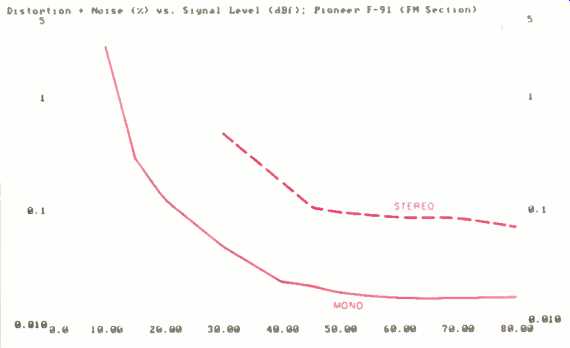
Fig. 2-THD + N vs. signal strength at 1 kHz, FM section.

Fig. 3-THD + N vs. modulating frequency, FM section.
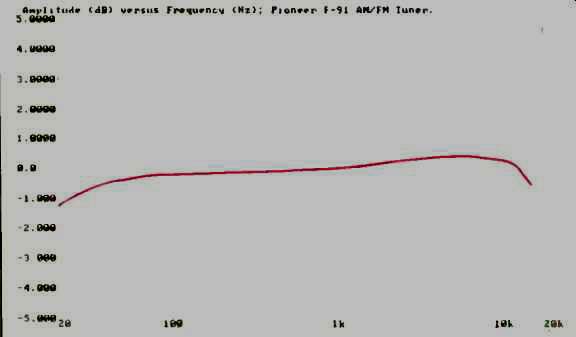
Fig. 4-FM frequency response.
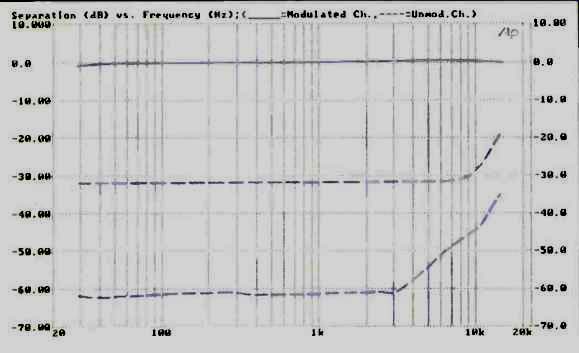
Fig. 5-FM frequency response (top curve; note change of scale from Fig. 4)
and separation with subcarrier products included (middle curve) and removed
(bottom curve). See text.
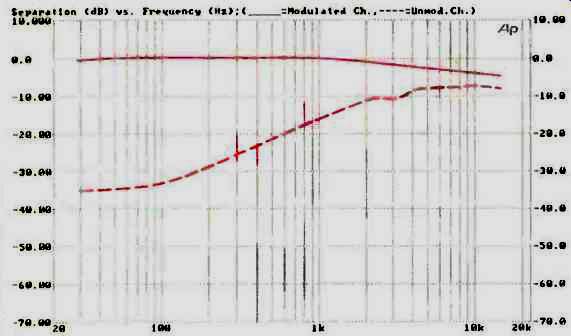
Fig. 6-FM frequency response (top curve) and separation (bottom curve) with
high-blend circuit on.
Figure 2 is a plot of THD + N versus input signal level.
Usable sensitivity in mono (the signal level at which noise plus distortion equals 3%) measured 10.0 dBf, close to the 9.8 dBf claimed by Pioneer. For strong signal levels, THD + N was an amazingly low 0.018% in mono. For a 1-kHz modulating frequency, stereo THD + N fell short of the claimed 0.02%, though it was certainly low enough: I measured 0.07% at 80 dBf and 0.085% at 65 dBf. Figure 3 shows how THD + N varied with modulating frequency. In mono, it measured 0.0095% at 100 Hz and 0.028% at 6 kHz.
In stereo, the results were 0.079% at 100 Hz and 0.056% at 6 kHz.
Figure 4 is a plot of frequency response for the FM section. Referenced to 1 kHz, there was a slight roll-off below 100 Hz, reaching-0.7 dB at 30 Hz. After a slight rise, amounting to no more than about 0.3 dB at 5 kHz, response went down to -0.5 dB at 15 kHz.
In the sample I tested, the subcarrier product output was high. In fact, when I attempted to measure stereo separation, the residual 19-kHz signal that was present made the separation appear to be no more than 32 dB, as indicated by the upper dashed curve of Fig. 5. Since this subcarrier product signal does not represent actual crosstalk, I inserted the filter that I normally use when measuring S/N ratio and THD + N. This filter has a cutoff frequency of 15 kHz, the highest audio frequency normally broadcast by FM stations. Once the filter was inserted in the measurement path, the separation reading increased to better than 61 dB at 1 kHz and 100 Hz, and 46 dB at 10 kHz, as shown in the lower dashed curve of Fig. 5.
Next, I turned on the F-91's high-blend circuit while keeping the filter in the signal-measurement path. Under these conditions, you can see in the dashed curve of Fig. 6 that separation remained well above 30 dB at low frequencies but that it decreased to less than 5 dB at 10 kHz. Note, too, that the frequency response of the modulated channel was affected by the blend. Response, shown by the solid curve in Fig. 6, was down 4 dB at 10 kHz.
Further evidence of the subcarrier leakage noted earlier was obtained when I made my usual spectrum analysis of the left- and right-channel outputs with a 5-kHz, left-only signal fully modulating the FM carrier. The sweep in Fig. 7 extends from 1 to 100 kHz. At 5 kHz, the modulated channel establishes the 0-dB reference level. Crosstalk at the output of the unmodulated channel is represented by the dashed curve, and, at 5 kHz, the separation is still a very high 58 dB. However, there is also a fairly high-level component at 19 kHz, only about 42 dB below the 5-kHz reference level, as well as a 38-kHz component that is only about 53 dB below the reference.
Capture ratio measured 1.0 dB. Alternate-channel selectivity measured almost exactly the 85 dB claimed. Image rejection was 72 dB, and AM suppression measured a very high 68 dB. Spurious-response rejection measured 85 dB, while i.f. rejection was greater than the 100 dB claimed by Pioneer.
The stereo threshold was set at 20 dBf. The three auto -tune settings (the signal strengths needed for the auto-tune mode to stop when intercepting a signal) measured 35, 45, and 50 dBf. The eight bars which indicate relative signal strength in the main display area were more meaningfully calibrated than usual. The first bar illuminates for signal strengths of about 30 dBf, the fifth bar at around 50 dBf, and all eight with signal strengths of 77 dBf.
The AM section was quite sensitive, measuring around 20 µV of directly applied signal for a 20-dB S/N ratio with a 30% modulated signal. Other published specs, such as selectivity, S/N, and image and i.f. rejection, were all met or exceeded. On the other hand, frequency response of the AM section (Fig. 8A) was very poor. Without applying the pre -emphasis called for by the new, voluntary National Radio Systems Committee Standard, response was down 6 dB at 80 Hz and 2.3 kHz, referred to 1 kHz. After applying the compensating pre-emphasis, high-frequency response improved somewhat, extending to 3.3 kHz for the-6 dB point (Fig. 8B). It is clear, however, that Pioneer has not tried to conform to the new NRSC de-emphasis recommendations.

Fig. 7--Separation and crosstalk components for 5-kHz FM modulating signal,
plus subcarrier and sideband components (see text).
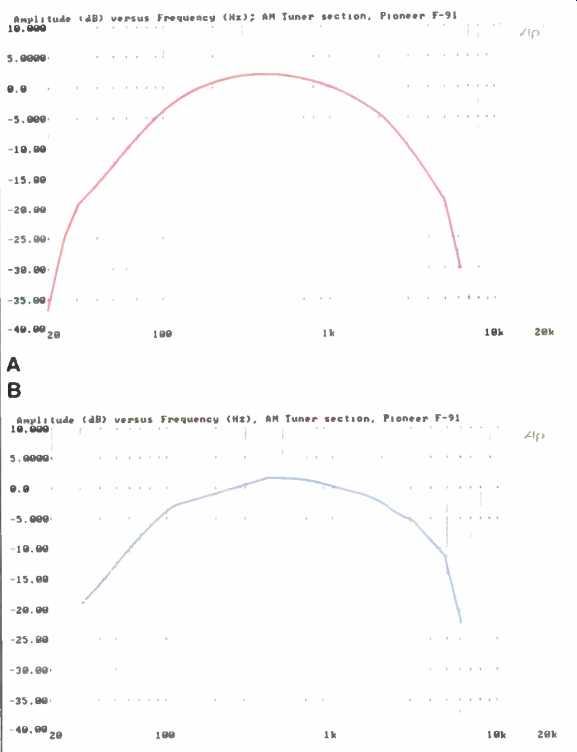
Fig. 8--AM frequency response for signals without (A) and with (B) NRSC pre-emphasis.
See text.
Use and Listening Tests
One of the things I liked most about the FM performance of the Pioneer F-91 was that the unit was able to deliver minimum distortion even when it was slightly detuned. This characteristic is associated with the ARTS feature. I logged 55 usable station signals when the tuner was connected to my rotatable outdoor antenna. With the "Tuning Mode" function set to Auto 2, the number of signals at which the tuner stopped was reduced to 43, while in the Auto 3 mode, the number of captured signals was further reduced to 34.
Those listeners who would prefer only the most noise-free FM reception possible would do well to select this mode.
Even stereo station signals received in the Auto 3 mode will have S/N ratios of around 65 dB, while mono signals will yield ratios of well above 80 dB. Of course, if using Auto 3 results in your missing some of your favorite stations, you can always switch back to Auto 2 or Auto 1. If residual noise during stereo reception is still too great, you have the additional option of switching in the high-blend circuit.
All of this versatility adds up to a tuner that should meet the needs of just about any FM radio enthusiast. Given a good, strong FM signal that is not over-modulated, the sound quality reproduced by the F-91, feeding one of my reference amplifiers and my reference speakers, was superb. Because so many FM stations now use Compact Discs as program source material, it's become almost essential to own a tuner capable of delivering the dynamic range that such discs demand. Of course, most stations use a fair amount of compression when playing discs that have an unusually wide dynamic range. Even so, it is not uncommon to receive signals that have at least 10 dB greater dynamic range than FM audio signals had in the pre-CD era. That makes this Pioneer tuner, with its S/N ratio of more than 80 dB, even in stereo, ideal for the digital audio age. I suspect (but have no proof) that the unusually high level of residual subcarrier product output was peculiar to my sample, since the tuner met, or nearly met, all its other specs. In any case, it shouldn't cause any problems unless you try to record an FM program onto your cassette deck, using Dolby NR and not using the deck's MPX input filter. The Pioneer F-91 must be considered as one of only a few models that can extract every bit of sound quality permitted by current FM transmission practices. Now all we need are more stations sending out signals that are good enough to be taken full advantage of by this and other high-quality FM tuners.
-Leonard Feldman
( Audio magazine, Aug. 1988)
Also see:
Pioneer Elite PD-65 CD Player (Dec. 1992)
Pioneer F-99X Tuner (Nov. 1985)
= = = =